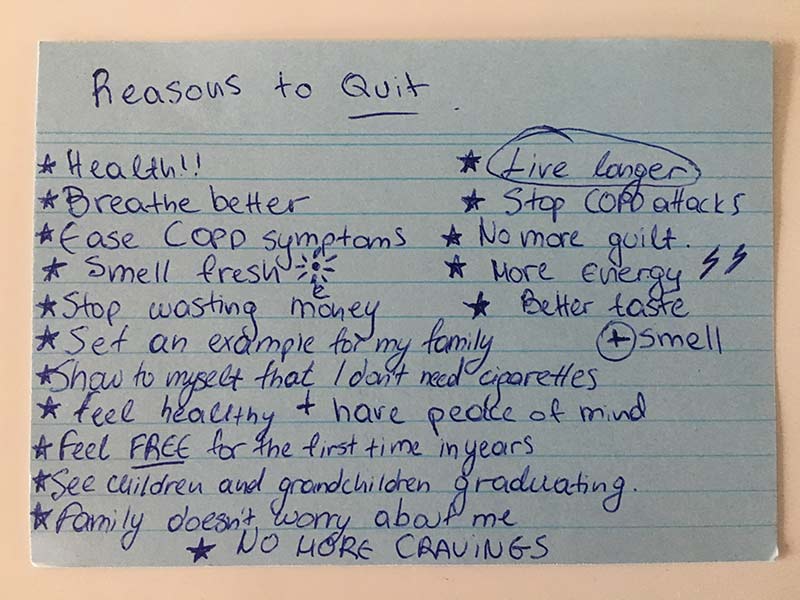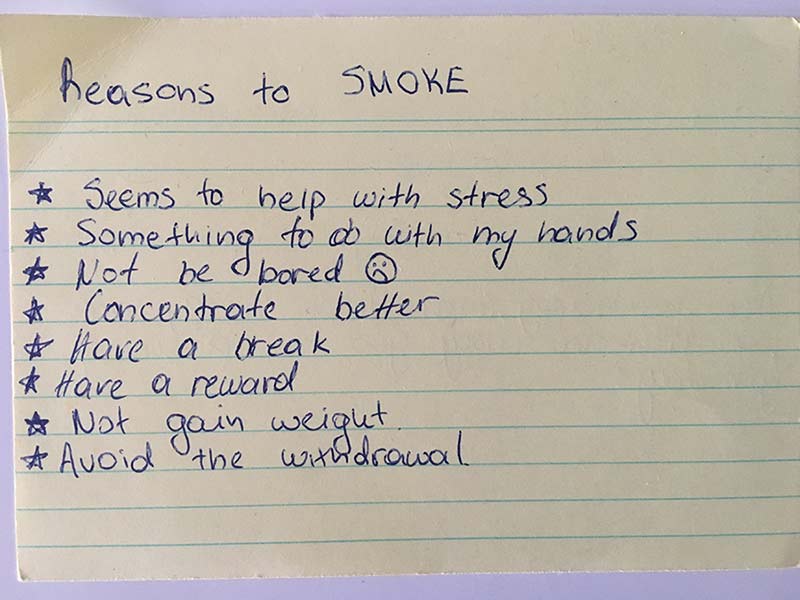The Connection Between COPD and Smoking
Who could ever really believe that a small stick of tobacco can cause so many problems?
Among the most life-draining of these problems, is the Chronic Obstructive Pulmonary Disease (COPD).
Maybe you’re here because a loved one has COPD, so you want to help them out.
Or maybe you’re struggling with COPD yourself, and you want to quit smoking but without missing cigarettes.
The American Lung Association and the Centers for Disease Control and Prevention (CDC) link 85 to 90 percent of COPD cases and 8 out of 10 COPD-related deaths to smoking.
Smoking is the leading cause of COPD.
That’s why it’s also the best treatment for COPD.
Every single research and health institute, from the Centers for Disease Control and Prevention to the Mayo Clinic and UK’s National Health System has established that the best treatment for COPD is no other than quitting smoking.
Quitting Smoking and COPD
If you’ve been diagnosed with COPD because of smoking, you naturally feel some sort of anger, disappointment, discouragement or even depression.
It is a tough situation.
No doubt about that.
And… Since the damage to your lungs has already been done, you might think that quitting smoking is not worth the struggle.
Perhaps you think that smoking is the only way you can cope with all the anxiety and the changes happening in your life right now.
You might even think that it’s too late to quit now. There are many reasons why smokers with COPD keep on smoking.
But is it too late to stop smoking?
Kathrin Nicolacakis, MD, a pulmonary specialist at the Cleveland Clinic in Ohio says that quitting smoking is the best COPD treatment that’s guaranteed to help you maintain the lung function you have left.
Think of COPD as a cracked mirror.
If you stop hitting the mirror, it will stay cracked. If you keep hitting it, it will break completely.
No matter what other COPD treatment you use – oxygen therapy, surgery, medication – if you keep cracking the mirror by smoking, it will eventually break.
That’s why the natural cure for COPD is to stop smoking and stop cracking the mirror.
Listen. No matter how long you have had COPD or how advanced it is, quitting smoking will slow down its progression and improve your quality of life.
In the beginning, you might feel no difference with your COPD because your lungs need some time to clear all the toxins.
After that, things only get better.
According to the American Lung Association (ALA), you experience marvelous stopping smoking benefits after your last cigarette.
Within 1 to 9 months your cough, sinus congestion, fatigue, shortness of breath and COPD flare-ups decline so much that you are able to live normally.
Ok so now you know how that quitting smoking is the best thing you can do for your COPD.
So the question is, HOW can you stop smoking?
And more importantly, how can you quit smoking naturally and easily so you can remain smoke-free forever?
How to Quit Smoking when you have COPD

If you’ve ever felt that quitting is hard, painful and even impossible… know that it doesn’t have to be that way. Not anymore.
There is a new way to stop smoking easily and permanently.
This way is the CBQ method.
The Cognitive Behavioural Quitting method – CBQ- has 94% success rate. 85% of smokers quit permanently on their first attempt and 9% quit on their second or third attempt. And you can quit too.
The CBQ is so successful because it follows the 4 quit smoking stages.
These stages are:
1. Choose to Quit.
In this stage, you commit to quitting smoking and create your quit plan.
2. Change Your Mindset.
Here you change how you think about smoking, break the fears that keep you from becoming a non-smoker, and strengthen your belief that you can succeed.
3. Change Your Smoking Pattern.
In this stage, you learn how to feel better without cigarettes and how to stop cigarette cavings so you can smoke your last cigarette.
4. Condition your Smoke Free Life.
In the last stage, you learn how to remain a non-smoker and how to feel relaxed, happy, and in peace without a cigarette in your hand.
So in this article, I will show you 3 exercises that belong to the 3rd quit smoking stage: Change Your Smoking Pattern.
Don’t worry if you haven’t started with the first stage yet. You can always access the exclusive video of the 4 stages here.
Just enter your name and email address so I will know where to send you the video.
For now, know that these quit smoking solutions that I’m about to share with you are a great way to test drive the CBQ method.
And they will help you stop smoking.
Ready??
1. Win Your Morning Cigarette
Why is taking control of the morning cigarette so important?
Because most smokers believe that the morning cigarette is the one they will miss the most when they quit.
Just the thought of waking up and not smoking is enough to bring our confidence down and prevent even the most determined among us from making a successful quit attempt.
Yes.
The fear of feeling deprived in the morning can keep us hooked to nicotine for life.
If you are like I was, you probably think that you can’t wake up properly without a cigarette.
Maybe you believe that your whole day will be stressful and overwhelming if you don’t get these first morning puffs.
Or maybe you’re worried that if you don’t smoke in the morning, you won’t be able to enjoy the rest of your day.
Well, if any of these are true for you know that you are not alone.
Most smokers feel they need a cigarette to enjoy their morning.
But is this cigarette really enjoyable?
And do we really NEED it?
The first cigarette of the day tastes awful- unless we smoke it while drinking our coffee or tea or after having breakfast.
For me having a cigarette immediately after brushing my teeth in the morning, was the most disgusting thing. It gave me cotton mouth and the taste was horrible. I still get the chills just thinking about it.
Still, what do you think happened when I didn’t have time to grab a coffee with my morning cigarette?
I still smoked it right after brushing my teeth!
Enjoyment had nothing to do with it. But I thought I needed it. Otherwise, my cravings would be too painful and intense.
But things changed when I started asking myself this question:
Why during the day, I can’t possibly go without cigarettes, but at night I can sleep 6,7 or 8 hours without smoking?
If the nicotine cravings were so painful then they would wake me up!
But we don’t wake up at night from the intensity of our cravings. Do we?
Why?
Because the physical cravings for nicotine can be so subtle that we don’t even notice them.
That’s why we don’t wake up every hour for a cigarette break.
Yet, if we go 8 hours in the day without smoking…. then the cravings become annoying and overwhelming.

Why is it that at night our cravings don’t bother us but when we are awake we feel we NEED a cigarette?
What’s different about sleeping and being awake?
What really changes?
What changes, is that our mind is awake.
And it is our mind that reminds us we haven’t smoked for so many hours.
It tells us that we need to smoke. Otherwise, we will be agitated and stressed all day.
It is our mind that misses the cigarette, not our body.
This happens because the smoking addiction is 80% mental and 20% physical.
The physical addiction to smoking is our body’s need for nicotine.
The mental dependence on smoking is how smoking makes us feel and how much we think we need it.
This is actually good news.
Because it means that we can easily avoid our morning cigarette, as long as we keep ourselves happy and busy in the morning.
When we see that there are other ways to feel good without smoking, then we don’t need to use willpower to resist a cigarette, because there is nothing to resist.

So how can you win over your morning cigarette and kick-start your day?
How to Start Your Day without Smoking
Here are some tips:
- Begin each day with a planned activity that will keep you busy. This can be talking a walk, showering, making a phone call.
- Write something down — Did you have any good ideas or dreams while you were asleep? Write them down right after you wake up or while drinking your coffee.
- Think of something you’re grateful for or excited about.
- Play a game on your phone to keep your hands busy.
- Begin each day with deep breathing.
- When your mind tells you “You need to smoke”, reply back. Take your most confident, empowering face and say “I don’t need to do anything” or say “later” or “shut up” (I used to say that to myself- To my surprise, it worked).
2. Keep Your Motivation High
All smokers have reasons to quit. These reasons are our motivation.
We want to be healthier and live longer to enjoy our time with our loved ones.
We also want to stop paying our hard earned money to the tobacco companies. Click here to check how much money you will save by quitting smoking.
And, of course, we want to breathe better so we can beat the painful COPD symptoms.
So yes, we all have some quit smoking motivation.
Then why don’t we do it?
What is stopping us?
Why does our motivation evaporate?
You might think that what destroys your motivation to quit comes down to self-destruction or weakness. That’s far from the truth.
What destroys our motivation to quit is…. our motivation to smoke.
On the one hand, we want to get back our health, wealth, and peace of mind.
On the other hand, we are motivated to keep on smoking because we are afraid of losing the cigarette friend that helps us relax, socialize and control our weight.
We simply have a conflict of motivations.
And quitting smoking is all about making our motivation to quit become greater than our motivation to smoke.

It’s about having more reasons to quit than to keep on smoking.
So now let’s do an exercise together to help you keep your motivation to quit high. If you can, do this exercise as you are reading this post (no better time than the present, right?)
It will only take a few minutes, I promise.
Okay, take a piece of paper or open a notes app on your phone or tablet.
We will make 2 lists.
On list #1 write ALL the quit smoking benefits. Or else, the reasons why you want to stop smoking.
On list #2 write ALL the smoking benefits. In other words, the reasons why you want to keep on smoking.
These 2 lists may look something like this:


I encourage you to spend 5 minutes writing everything that comes to your mind…
And when you finish, check your lists.
Which list is bigger?
Do you have more reasons to quit or more reasons to smoke?
And which reasons are more important? The ones on the first list or the second?
I think you already know.
So every time you feel like giving up on your decision to quit, look at these lists.
This will keep your motivation high.
Moving on.
I bet that somewhere on your Reasons to Smoke list, you wrote about stress. Right?
This brings me to our next point.
3. How to Bring Your Stress Down
COPD and Smoking can increase your anxiety.
See, all smokers face daily stress. But having COPD is a stressful situation all by itself.
Just knowing that your lungs are harmed, is distressing. It creates guilt. And guilt is a big burden to carry.
And having to cope with symptoms like chest tightness, wheezing, constant coughing, tiredness, headaches and swollen feet, is not only stressful but also painful.
Now being hooked on oxygen tanks goes beyond stressful.
And then there is the loving pressure to quit that comes from your loved ones.
This can be a lot to handle, right?
The more problems you’re facing, the more you feel you need smoking. The very thing that caused all of these problems.
It doesn’t make sense but for some reason, it appears to help.
But does it really help?
As if the existing stress in your life wasn’t enough, you now have the stress coming from your nicotine cravings.
Cravings are very agitating.
They make us tense.
Anxious.
When we crave, we can’t think of anything else other than smoking.
So we smoke.
When we smoke, we relieve the irritating craving.
But every cigarette we smoke also causes our next cigarette craving. And when the next craving comes, what happens?
We feel stress if we don’t smoke to satisfy that craving too.
So we smoke again. And the same vicious circle repeats itself 20, 30, 50 times a day until the end of our lives.

Smoking is not relaxing us.
On the contrary, it’s causing us stress all day, every day.
It’s true. Smokers are more stressed than non-smokers.
Yep, that’s right.
Although smoking a cigarette might feel like an effective mood control, being addicted to nicotine increases your anxiety.
So our goal is to remain smoke-free and stress-free.
Remember what we talked about earlier in this post.
A successful and easy quit attempt happens when we know how to cope with our biggest cravings BEFORE we have to face them.
The key here is to start managing your stress without cigarettes BEFORE you smoke your last cigarette.
That way, you will know exactly what to do when a craving strikes.
Your anxiety will go down.
You won’t feel overwhelmed.
You will be prepared. And it will work.
If you think that this is hard, let me reassure you that it is not.
The only reason you feel you need smoking to relax is this: You never had the chance to learn how to relax without a cigarette.
That doesn’t mean that you can’t relax without smoking.
You can. I promise you.
All you have to do is to experiment with new ways to relax without smoking.
Here are a few tips to get you started:
How to Relax without Smoking

1. Focus on today.
Really, when you feel overwhelmed tell yourself “Focus on today”. Forget about yesterday or tomorrow. Take it one day at a time. Solve one problem at a time.
Focus on getting through today. Then focus on getting through tomorrow when it comes.
2. Write it down.
Recharge your mind by writing down your thoughts.
Don’t let all these worries run around in your head. That way, they get bigger and they blow out of proportion.
Instead, take a pen and a paper and start writing down what’s stressing you out.
Then ask yourself: Will smoking solve this problem?

3. Get perspective.
What helped me (and still helps me) calm down when I was stressed and anxious was getting some perspective on my problems. I was asking myself these questions:
- Is anyone else on this planet going through a harder time right now?
- And what would my best friend (spouse, mother, grandmother, son, daughter) say to me about this problem?
Conclusion
Now you can how to deal with COPD and smoking.
The fastest way to get started is to use the 3 tools from the quit smoking stage – Change Your Smoking Pattern:
- How to smash your morning cigarette
- How to keep your motivation to quit high
- And how to tackle stressful situations without cigarettes.
To quit smoking permanently and easily, makes sure you follow the 4 stages of the CBQ method.
These 4 stages take you from where you are now to a happy non-smoker.
And they are designed to help you quit even if you love smoking.
Click here to request access to the exclusive video of the 4 stages.
It’s 100% free.
All you need to do is enter your name and email address so I can send you the link to the video.
Get the 4 stages of the CBQ method now.
See you on the inside!


